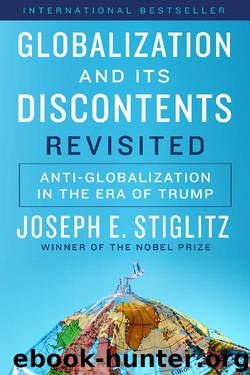Globalization and Its Discontents Revisited by Joseph E. Stiglitz

Author:Joseph E. Stiglitz [Stiglitz, Joseph E.]
Language: eng
Format: epub
Publisher: W. W. Norton & Company
Published: 2017-12-08T05:00:00+00:00
THE CHALLENGES AND OPPORTUNITIES OF TRANSITION
As the transition began in the early 1990s, it presented both great challenges and opportunities. Seldom before had a country deliberately set out to go from a situation where government controlled virtually every aspect of the economy to one where decisions occurred through markets. The People’s Republic of China had begun its transition in the late 1970s, and was still far from a full-fledged market economy. One of the most successful transitions had been Taiwan, 100 miles off the shore of mainland China. It had been a Japanese colony since the end of the nineteenth century. With China’s 1949 revolution, it became the refuge for the old Nationalist leadership, and from their base in Taiwan, they claimed sovereignty over the entire mainland, keeping the name—“the Republic of China.” They had nationalized and redistributed the land, established and then partially privatized an array of major industries, and more broadly created a vibrant market economy. After 1945 many countries, including the United States, moved from wartime mobilization to a peacetime economy. At the time, many economists and other experts feared a major recession would follow wartime demobilization, which entailed not only a change in how decisions were made (ending versions of command economies in which wartime governments made the major decisions about production and returning to private sector management of production) but also an enormous reallocation of production of goods, for example, from tanks to cars. But by 1947, the second full postwar year, production in the United States was 9.6 percent higher than 1944, the last full war year. By the end of the war, 37 percent of GDP (1945) was devoted to defense. With peace, this number was brought down rapidly to 7.4 percent (1947).
There was one important difference between the transition from war to peace, and from communism to a market economy, as I will detail later: Before World War II, the United States had the basic market institutions in place, even though during the war many of these were suspended and superseded by a “command and control” approach. In contrast, Russia needed both resource redeployment and the wholesale creation of market institutions.
But Taiwan and China faced similar problems to the economies in transition. Both faced the challenge of a major transformation of their societies, including the establishment of the institutions that underlay a market economy. Both have had truly impressive successes. Rather than prolonged transition recession, they had close to double-digit growth. The radical economic reformers who sought to advise Russia and many of the other countries on transition paid scant attention to these experiences, and the lessons that could be learned. It was not because they believed that Russian history (or the history of the other countries making the transition) made these lessons inapplicable. They studiously ignored the advice of Russian scholars, whether they were experts in its history, economics, or society, for a simple reason: they believed that the market revolution which was about to occur made all of the knowledge available from these other disciplines irrelevant.
Download
This site does not store any files on its server. We only index and link to content provided by other sites. Please contact the content providers to delete copyright contents if any and email us, we'll remove relevant links or contents immediately.
The Meaning of the Library by unknow(2391)
Six Billion Shoppers by Porter Erisman(2229)
Why Nations Fail: The Origins of Power, Prosperity, and Poverty by Daron Acemoglu & James Robinson(2180)
No Time to Say Goodbye(1999)
Red Notice by Bill Browder(1935)
The Economist [T6, 22 Thg9 2017] by The Economist(1845)
Currency Trading For Dummies by Brian Dolan(1793)
Thank You for Being Late by Thomas L. Friedman(1680)
Bitcoin: The Ultimate Guide to the World of Bitcoin, Bitcoin Mining, Bitcoin Investing, Blockchain Technology, Cryptocurrency (2nd Edition) by Ikuya Takashima(1615)
Amazon FBA: Amazon FBA Blackbook: Everything You Need To Know to Start Your Amazon Business Empire (Amazon Empire, FBA Mastery) by John Fisher(1496)
Coffee: From Bean to Barista by Robert W. Thurston(1422)
The Future Is Asian by Parag Khanna(1402)
The Great Economists by Linda Yueh(1394)
Capitalism Without Capital: The Rise of the Intangible Economy by Jonathan Haskel(1342)
Pocket World in Figures 2018 by The Economist(1329)
How Money Got Free: Bitcoin and the Fight for the Future of Finance by Brian Patrick Eha(1322)
Grave New World by Stephen D. King(1317)
The Sex Business by Economist(1284)
Cultural Intelligence by David C. Thomas(1204)
